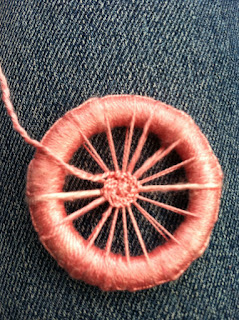The wagon wheels I refer to are buttons - namely Dorset Buttons in the wagon wheel design. I've blogged about these beautiful little buttons before - how they were created in Britain in the 17th century. Button makers in Dorset, England, became so expert and productive in making these buttons that an entire industry developed, only to collapse in the 19th century when button-making became industrialized.
Dorset Buttons, specifically the wagon wheel style pictured above, can be highly elaborate and beautiful, almost like jewelry. I love to make them. And what's best about this technique - for people who make garments - is that you can create one-of-a-kind buttons using the same yarns that you used in your garment. (I don't think it's unusual for textile nuts like me to spend hours on the Internet - even worse, wandering around JoAnn's or traveling to New York or Toronto to visit one of those wonderful stores that sell only buttons, scouring the store, and then buying only ONE button.)
They travel well, too. All you need is a plastic ring, yarn, a tapestry needle, and embroidery scissors. And beads, if you choose. All of which can fit into a purse.
On the road back and forth to Philly to visit family for Passover, I practiced my buttony. (That's what the British call it. Sounds British, doesn't it?)
Here's my favorite.
This one was made using beading thread: Micro C-Lon Cord, in purple (doesn't show up well in the photo), orange, and chartreuse, along with matching seed beads. If you look closely at the photo, you may be able to see that the purple beads and the orange beads are iridescent, which I really like.
Here's another wagon wheel. This uses hand-dyed 20/2 spun silk yarn in navy and fuchsia. I embellished it with French knots in pale pink silk. Flowers for spring!







No comments:
Post a Comment